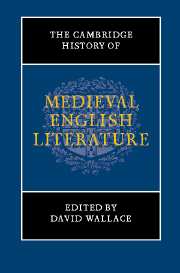Book contents
- Frontmatter
- I AFTER THE NORMAN CONQUEST
- II WRITING IN THE BRITISH ISLES
- III INSTITUTIONAL PRODUCTION
- Introduction
- 12 Monastic productions
- 13 The friars and medieval English literature
- 14 Classroom and confession
- 15 Medieval literature and law
- 16 Vox populi and the literature of 1381
- 17 Englishing the Bible, 1066–1549
- IV AFTER THE BLACK DEATH
- V BEFORE THE REFORMATION
- Chronological outline of historical events and texts in Britain, 1050–1550
- Bibliography
- Index of manuscripts
- Index
- References
12 - Monastic productions
from III - INSTITUTIONAL PRODUCTION
Published online by Cambridge University Press: 28 March 2008
- Frontmatter
- I AFTER THE NORMAN CONQUEST
- II WRITING IN THE BRITISH ISLES
- III INSTITUTIONAL PRODUCTION
- Introduction
- 12 Monastic productions
- 13 The friars and medieval English literature
- 14 Classroom and confession
- 15 Medieval literature and law
- 16 Vox populi and the literature of 1381
- 17 Englishing the Bible, 1066–1549
- IV AFTER THE BLACK DEATH
- V BEFORE THE REFORMATION
- Chronological outline of historical events and texts in Britain, 1050–1550
- Bibliography
- Index of manuscripts
- Index
- References
Summary
This history of monastic productions begins, paradoxically, at the end of what are termed the ‘monastic centuries’, when the type of monastic life dominant in Britain had already begun to undergo drastic and widespread change. British monastic life had grown, as it had in all the western Church, from the seed planted in a variety of scriptural prescriptions for the ideal Christian life. Monks and nuns had responded in particularly concrete terms to the injunction Jesus made to all his disciples to leave all they had (‘fratres aut sorores aut patrem aut matrem aut filios aut agros’) that they might ‘receive an hundredfold and possess life everlasting’ (‘centuplum accipiet, et vitam aeternam possidebit’), and they had tried to retreat from the world into a mode of contemplative living, as it was sometimes conceived, ‘in the desert’. A variety of programmes, or rules, had arisen to direct their retreat, and the Rule that had predominated from the eighth to the twelfth centuries in Britain and all the western Church alike was written by St Benedict (d. 547) in the first part of the sixth century. The character of Benedictine monasticism was shaped by ‘regular’ obedience to the simple but austere plan for daily life this Rule provided (‘in omnibus igitur omnes magistram sequantur regulam … nullus in monasterio proprii sequatur cordis voluntatem’ [in all things, therefore, let all follow the Rule as master … let no one in the monastery follow the will of his own heart]), although the general nature of St Benedict’s prescriptions (he spoke to ideals more than to practicalities) and the absence of any constitution for standardizing observance (‘general chapters’ were not introduced until after the Fourth Lateran Council in 1215) left room for considerable variation in this regular observance over time.
- Type
- Chapter
- Information
- The Cambridge History of Medieval English Literature , pp. 316 - 348Publisher: Cambridge University PressPrint publication year: 1999
References
- 3
- Cited by

